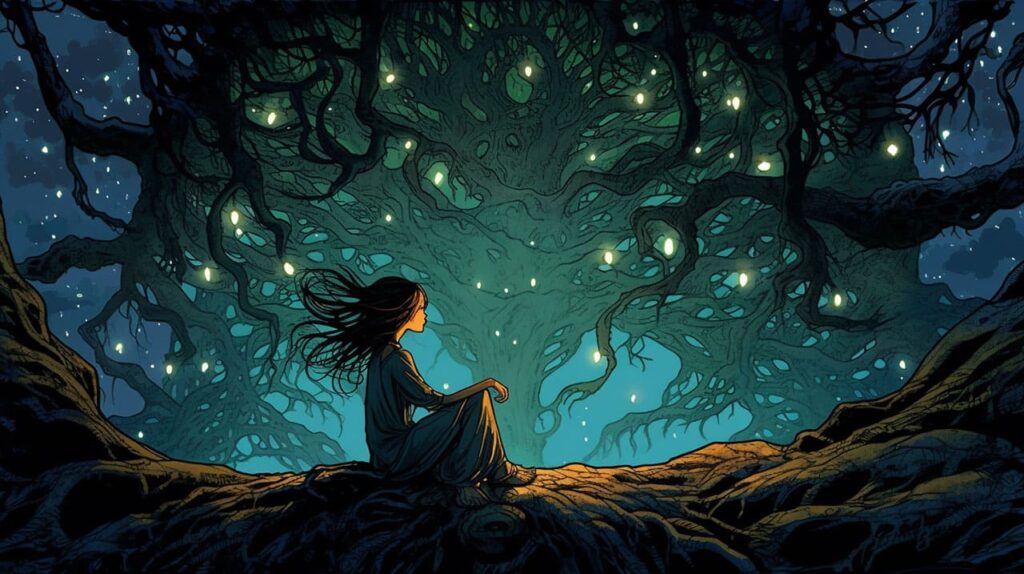





Mythical and mystical connections surround us in nature, even if we don’t see them. Within the depths of the forest, ancient trees whisper secrets to one another, while hidden creatures of folklore lurk in the shadows. The shimmering waters of lakes and rivers hold the essence of mythical beings, their enchanting presence felt in every gentle ripple. Even the celestial bodies above, like the moon and stars, seem to possess an otherworldly power, casting a mysterious glow upon the earthly realm. Though unseen by our mortal eyes, these ethereal connections infuse the natural world with a sense of magic and wonder.
Nature’s mythical and mystical tapestry extends beyond the realm of sight, inviting us to explore with our imagination and intuition. It is in the rustling of leaves, the caress of a gentle breeze, and the songs of birds that we can discern the echoes of ancient legends and tales. By immersing ourselves in nature, we open our hearts and minds to the possibility of encountering unseen realms, where mythical creatures roam and spirits reside. In this way, nature becomes a gateway to the mystical, where we can sense the invisible threads that connect us to the realms of imagination and the wonders that lie just beyond our perception.
The paintings above celebrate these mythical and mystical connections. They were painted using fine-tip paint markers and each one celebrates the feminine energy of a mythical or mystical connection inspired by nature:
- Nymph of the Forest
- Siren of the Sea
- Guardian of the Moon
- Oracle of the Forest
- Phoenix Ascending
- Muse of the Aurora
What is the connection between nature and myth?
The connection between nature and myth is deeply intertwined. Nature has long been a source of inspiration for mythologies around the world. Myth often weaves stories and legends that explain natural phenomena, such as the creation of the world, the changing of seasons, or the behavior of animals. Nature serves as a backdrop for mythical events and characters, providing a rich and evocative setting that reflects the awe and wonder associated with the natural world. Moreover, myths frequently personify natural elements, attributing human-like qualities and characteristics to natural forces, creatures, and landscapes.
What is an example of a nature myth?
One example of a nature myth is the Greek myth of Persephone and the changing seasons. According to the myth, Persephone, the daughter of the goddess Demeter, was abducted by Hades, the god of the underworld. Demeter, in her grief and anger, caused the earth to become barren, resulting in winter. When Persephone was allowed to return to the surface for part of the year, Demeter’s joy brought about the blossoming of flowers and the return of spring and summer. This myth explains the cycle of seasons and the connection between the natural world and the gods in Greek mythology.
What mythical creatures are associated with the earth element?
Several mythical creatures are associated with the earth element. Some examples include:
- Gnomes: These creatures are believed to be earth elementals associated with the underground. They are often depicted as small, bearded beings that dwell in caves or deep within the earth.
- Elves: In various mythologies, elves are connected to nature and the earth. They are often portrayed as graceful, nature-loving beings with a deep affinity for forests and natural landscapes.
- Dwarves: Dwarves are mythical creatures commonly associated with mountains and the earth. They are depicted as skilled craftsmen and miners, living in underground caverns and possessing great strength and endurance.
- Golems: Originating from Jewish folklore, golems are creatures made of clay or earth. They are created and brought to life through magical means, often serving as protectors or servants.
What is a nature myth?
A nature myth is a type of myth that revolves around natural elements, forces, and phenomena. It often explains aspects of the natural world, such as the origins of mountains, rivers, or celestial bodies, the behavior of animals, or the changing of seasons. Nature myths reflect the deep connection between human beings and the natural environment, providing cultural and symbolic meanings to various aspects of nature. They offer narratives and stories that help humans make sense of the natural world, imparting wisdom, moral lessons, and a sense of wonder.
